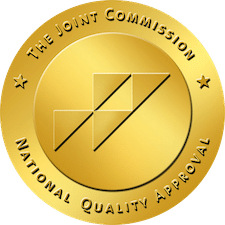Rates of Generalized Anxiety in the United States have skyrocketed in recent years. From events like 9/11 to the recent COVID-19 pandemic, anxiety has developed in millions of Americans. If you think you have anxiety, take our free self-test to see if you need further treatment.

Do I Have Anxiety?
Anxiety Self-Test
Rates of Generalized Anxiety in the United States have skyrocketed in recent years. From events like 9/11 to the recent COVID-19 pandemic, anxiety has developed in millions of Americans. If you think you have anxiety, take our free self-test to see if you need further treatment.
Table of Contents
The events of the past several decades traumatized Americans on an unprecedented scale. With a war verging on its second decade, climate change destroying homes, and several epidemics cropping up, it would be impossible not to feel nervous. It’s no secret that anxiety rates in the United States have skyrocketed over the past few years. The endless line of cultural traumas we’ve experienced plays no small role in this.
However, even with all this stress, it can be hard to tell if what you’re experiencing is normal or a clinical condition. “Do I have anxiety?”, you ask yourself after your third consecutive night of limited sleep. Here’s how you can tell, and what you can do if you or someone you love has been experiencing anxiety symptoms.
Do I Have Anxiety? Common Screening Questions
To start us off, let’s dig into some common questions health providers will ask when you mention struggling with anxiety. The following questions are adapted from the official self-screening anxiety test offered by the Anxiety and Depression Association of America and should serve as a jumping-off point from which you can better understand the rest of the article.
Take Our Free Generalized Anxiety Quiz
This test is not a diagnostic tool, nor is it intended to replace a proper diagnosis. Use it only for informational purposes. Mental health conditions should only be diagnosed by a licensed mental health professional or doctor. Regardless of your results from our assessment, you should speak to a doctor about your mental health.
When Does Stress Cross the Line Into Anxiety?
With the current state of affairs, you may feel like it’s natural to be stressed out and concerned. So, the question becomes, when does normal stress cross the line into an anxiety-based disorder?
The line can be tricky to decipher. However, if you go by the official words of the DSM-V, this line gets crossed when your worries and fears become clinically disruptive. What this means is that it is difficult or impossible for you to make it through your daily tasks without experiencing symptoms from your anxiety, whether physical or mental.
(And, as a side note, if questioning “Do I have anxiety?” sends you spiraling into an anxious episode, you probably do have it.)
Understanding the Different Types of Anxiety
There are many different types of anxiety disorders that you or a loved one may experience. Each of these presents with different symptoms and may require different treatment methods. Below, we have a list of the five most common subtypes of anxiety disorders. If any of these resonate with you, feel free to check out the Symptoms heading associated with your subtype.
Generalized Anxiety Disorder
Generalized Anxiety Disorder is the subtype of anxiety most often diagnosed when the symptoms you experience don’t align closer to another subtype. Rather than having their anxiety centered around a specific trigger or triggers, those with Generalized Anxiety Disorder may experience excessive and persistent worry over a variety of things.
Social Anxiety Disorder
Social Anxiety Disorder is a subtype of anxiety characterized by excessive worry and panic during social situations or when surrounded by people. Sufferers may fear and feel that they are being judged for their every move when out in public to such an extent that they avoid entering the public eye at all. The difference between Social Anxiety Disorder and introversion lies in the level of fear and avoidance of social stimuli.
Obsessive-Compulsive Disorder
Obsessive-Compulsive Disorder, far from being neat and tidy, is an anxiety subtype characterized by obsessive worrying and compulsive action. OCD sufferers often experience repetitive, obsessive thoughts about various situations and stimuli. These then lead to compulsions and rituals to drive the obsession away. For example, someone with contamination-based OCD may fear that every surface they touch is unclean, leading them to wash their hands until they bleed.
Post-Traumatic Stress Disorder
Post-Traumatic Stress Disorder, despite its common presentation in media, is not solely the purview of shell-shocked veterans. PTSD is an anxiety disorder characterized by an adverse psychological reaction to trauma. This trauma can be from a single incident (PTSD) or a long series of incidents (C-PTSD). However, in either case, the body and mind react as if the trauma were still fresh any time a stimulus reminiscent of the original trauma arises.
Panic Disorder
Panic Disorder is a subtype of anxiety characterized by rapid onset attacks of panic or fear. While an occasional pang of panic can be a normal response to stressors, those with Panic Disorder will experience these attacks on a regular basis and for no readily apparent reason. Because these attacks seem to come at random, those who don’t have this disorder may not understand why sufferers are suddenly struggling with a panic attack over something minor.
Symptoms of Anxiety Disorders
Now that we’ve discussed the five different subtypes of anxiety, let’s take a closer look at how each of these disorders presents itself. While some anxiety symptoms are shared across all subtypes, each one has some unique symptoms which can help your therapist or physician understand how best to treat you.
Symptoms of GAD
As the most “general” type of anxiety disorder, the symptoms of GAD can cover a broad range. The most common symptoms of GAD that physicians will look for include:
- Persistent, out-of-proportion worry or anxiety about a large number of events in one's life
- A constant leap to the worst-case scenario of every situation
- Inability to let worries go, even after they're proven unfounded
- Inability to relax or sleep due to a constant on-edge feeling
- Perceiving mundane situations as threatening
- Insomnia, tension, and muscle aches triggered by the constant stress and anxiety
If you’ve experienced one or more of these symptoms for a period of six months or longer, you may have GAD. We have a treatment plan and coping mechanisms listed for you later in the article.
Symptoms of OCD
As mentioned above, OCD is not merely an obsession with order and making things “right” for the sake of neatness. Rather, this disorder is characterized by the following common symptoms:
- Obsessive, intrusive fear of contamination or contaminating others
- Intrusive, unprompted thoughts of sex or violence
- Excessive focus on moral or religious purity
- Extreme superstitious behavior and fear of bad luck
- Repetitive behaviors such as counting, checking, or cleaning
- A sense of temporary relief from the obsessive thought after engaging in the compulsive, repetitive behaviors
OCD can be difficult to cope with, but later on, we have some methods listed that we hope will help you.
Symptoms of PTSD
PTSD can be simultaneously easier and harder to diagnose than its other anxiety subtypes due to its focus on traumatic events. However, due to common misconceptions, it can be hard for you to know if your symptoms “count” as PTSD. However, if you’ve experienced the following:
- Intense panic and distress at symbolic or real reminders of the trauma
- Vivid flashbacks that make you feel like the trauma is currently happening
- Intrusive images or thoughts relating to a traumatic event
- Extreme hypervigilance and constant anxiety due to feeling unsafe
- Nightmares about the trauma
…then, no matter what trauma you’ve experienced, you may have a degree of PTSD. Later on, we have some tips that may help you ground yourself when in the midst of a flashback or other PTSD-based episode.
Symptoms of Panic Disorder
Since Panic Disorder is most centered around panic attacks, we feel it prudent to discuss the most common symptoms of panic attacks here. When having a panic attack, you may experience the following:
- Racing heartbeat or palpitations
- Inability to breathe or a choking sensation
- Pins and needles or numbness
- Dizziness or faintness
- A sense of dissociation from your body or surroundings
- Feeling like you're going crazy or losing control
It’s not uncommon for those who have Panic Disorder to rush to the ER with symptoms that feel like a heart attack, only to be told they are perfectly healthy. If this has happened to you or someone you love, you may benefit from some of the panic attack coping mechanisms we discuss later.
Understanding the Common Causes of Anxiety
With a better understanding of the symptoms of anxiety disorders, you may wonder what causes these issues to arise in the first place. There are many different causes for anxiety disorders, but the most common and agreed-upon ones include:
Stress
While a simple stressor does not an anxiety disorder make, persistent exposure to stress can lead to developing an anxiety disorder. This becomes especially apparent in low-wage employees and students, who are inundated with stress-inducing expectations and little chance to take the pressure off of themselves. In fact, this stress is getting worse for students as more and more are forced to turn to remote learning for their schooling needs.
Trauma
Another common cause of anxiety disorders, especially in the case of PTSD, is trauma. There are many different traumatic events that may trigger an anxiety disorder. Common traumas may include:
- Experiencing physical or sexual violence
- Bullying and harassment
Car crashes - Sudden injuries or losses
- Fighting or living in a warzone
- Domestic or childhood abuse
Many of these traumas can lead to an anxiety diagnosis later in life, if not full-on PTSD.
Heredity
Anxiety disorders are highly heritable conditions. Chances are, if anyone in your family suffered from an anxiety disorder, you may end up dealing with one yourself.
Drug and Alcohol Abuse
With drug and alcohol abuse, this can become a chicken-and-egg scenario. Many turn to drugs and alcohol to self-medicate anxiety disorders, but the chemical imbalances these substances cause in the brain may themselves cause anxiety symptoms to form. Regardless of which came first, tapering off your drug or alcohol use can help your symptoms immensely.
Comorbid Disorders
If you already deal with a mental health disorder like depression or Seasonal Affective Disorder, your chances of also suffering from an anxiety disorder skyrocket. Mental health conditions are often comorbid with one another, requiring specialized treatment plans to create a sense of balance.
Treatment Plans for Anxiety Disorders
If you suffer from an anxiety disorder, it may seem like the end of the world. However, help is out there. There are a host of different treatment plans and coping mechanisms to help you with your symptoms, no matter which subtype of anxiety you experience. We’ve broken down some common treatment options and coping mechanisms for each subtype below.
Treatment Plans and Coping Mechanisms for GAD
Most treatment plans for GAD incorporate a combination of therapy and medication. While mild cases of GAD may respond to psychotherapy or Cognitive Behavioral Therapy alone, more severe ones will require the aid of antidepressants, mood stabilizers, or even sedatives.
In your day to day life, however, you should incorporate the following coping mechanisms and self-care tips to improve your GAD symptoms:
- Avoid drugs, alcohol, nicotine, and excessive caffeine
- Try to get enough sleep
- Avoid unhealthy, processed foods and eat a nutritionally balanced diet
- Remain physically active
- Join an anxiety support group
- Remain socially connected
By avoiding unnecessary stimulants and maintaining a solid social support network, you can better manage your generalized anxiety symptoms.
Treatment Plans and Coping Mechanisms for Socially Anxiety Disorder
While medication and some herbal remedies like kava or valerian can help with the symptoms of Social Anxiety Disorder, CBT, psychotherapy, or DBT remain the best ways to treat the issue. Systemic Desensitization may also help reduce the severity of the symptoms. Common treatment methods and coping mechanisms may include:
- Practicing for a social situation with a trusted friend or in front of a mirror
- Practicing relaxation and stress management techniques before and during a social situation
- Reflect on your social experiences of the day by journaling about them
- If and when you do embarrass yourself, let yourself experience those feelings, then let them go
By practicing these techniques, you may find that people are more welcoming and forgiving than your social anxiety wants you to think. Keep at it, and you’ll be socializing without excess fear.
Treatment Plans and Coping Mechanisms for OCD
OCD, as mentioned above, can prove a tricky beast to treat. While medications may help with the anxiety-based symptoms, the root thought processes and behaviors of the disorder cannot be treated by medication alone. Thus, OCD benefits from a variety of therapeutic techniques, including:
- CBT and Imaginal Exposure
- Psychotherapy or talk therapy to discuss common obsessions and how to handle the compulsions
- Journaling your experience with OCD episodes
- Finding ways to mentally and physically refocus when caught in a feedback loop
- Remind yourself of the indisputable facts
Be willing to engage with your OCD, but don’t fight it. By working with your brain instead of against it, you and your therapist can work as a team to improve your quality of life.
Treatment Plans and Coping Mechanisms for OCD
One of the biggest obstacles in tackling PTSD is establishing the source of your trauma and what may trigger an episode. It may require you to dig deep into memories you’d rather leave forgotten, but with the aid of a skilled therapist, you can discover your potential traumas and triggers and find ways to work with them.
Common treatment plans and coping mechanisms for this condition may include:
- Narrative therapy to help you reframe the events surrounding your trauma
- Grounding and relaxation techniques to aid you in the midst of a flashback
- A social support network that is willing to work around/help you process your triggers
- Medications such as mood stabilizers or antidepressants to help with the symptoms or comorbid disorders
A proper social support network is crucial to the treatment of PTSD, especially in cases where the trauma’s source is the family or a former partner. So, if you’re in treatment for PTSD, be willing to examine your social circle and find who’s worsening your symptoms. You’d be surprised how much more progress you can make when those who do you harm are no longer involved in your healing.
How to Cope with Panic Attacks
No matter your subtype of anxiety, you could end up experiencing a panic attack. These attacks can be sudden and terrifying in their onset. Worse, they never seem to arrive at a time when you can process them safely. If you begin experiencing a panic attack, the following coping mechanisms may help you:
- Use deep-breathing techniques to take slow, deliberate breaths
- Close your eyes and recognize that you are having a panic attack
- Ground yourself with your senses and mentally catalog what you can feel, see, hear, taste, and smell
- Practice conscious muscle relaxation to release tension
- Remove yourself from the trigger if you can
Panic attacks are, by their nature, terrifying experiences. However, they are not, despite what your body and brain might want you to believe, fatal. Nor are they the end of the world. You’ve experienced them before, likely will again, and have made it through each time. You can handle this.
Creating an Anxiety Support System
Nothing hampers your treatment plan more than an improper support network. If you are not the one suffering an anxiety disorder, but you know or love someone who is, you should make creating a safe environment for them one of your greatest priorities. Below, we have some tips for how you may support those with anxiety disorders in your life.

Supporting an Anxious Spouse
The biggest thing you can do to help support an anxious spouse is to listen to them. Don’t belittle their concerns. Even if they seem trivial to you, their anxieties are world-consuming to them. You can validate their feelings without worsening their anxious thinking.
Be willing to offer them space if they request it. It’s nothing personal against you. Your spouse may simply need some alone time to process their anxieties without feeling pressured to feel “better”.

Supporting an Anxious Child
As a parent, your only concern should be making your child feel safe. If you make them feel invalidated or unheard when they come to you in the midst of an anxious episode, or worse, tell them to “get over it” when they lack the tools to do so, they won’t have that sense of safety. If they don’t feel safe trusting you with their mental health, they won’t come to you for anything else.

Supporting an Anxious Employee
When an employee suffers from anxiety in the workplace, it can be difficult to find the right way to deal with it. Our best suggestion is to be willing to put your ego or attitudes about productivity aside. We promise you, your employee feels far worse about suffering these symptoms at work than you do.
Be willing to give them time and space to work through the panic attack. Find ways to work with and around their triggers where possible.
Feeling Overwhelmed and Anxious? Let Us Help You
Dealing with any anxiety disorder can be a life-changing situation. If you’ve found yourself wondering, “Do I have anxiety?”, and aren’t sure what to do, let the Southern California Sunrise Recovery Center help you. We specialize in treating a variety of mental health issues and will be more than happy to assist you or a loved one in their treatment.
Don’t let your thoughts and emotions continue to sweep you or a loved one away. Reach out to our team of experts today for the assistance you need.
References
- https://www.mhanational.org/issues/state-mental-health-america
- https://adaa.org/find-help/treatment-help/self-screening
- https://socalsunrisemh.com/treatments/anxiety-treatment/
- https://www.helpguide.org/articles/anxiety/obssessive-compulsive-disorder-ocd.htm
- https://www.nbcnews.com/news/education/remote-students-are-more-stressed-their-peers-classroom-study-shows-n1257632
- https://www.alcoholrehabguide.org/alcohol/drinking-drugs/
- https://socalsunrisemh.com/our-program/cbt-therapy-orange-county/
- https://socalsunrisemh.com/programs/systematic-desensitization/
- https://socalsunrisemh.com/programs/psychotherapy/
- https://socalsunrisemh.com/our-program/narrative-therapy-orange-county/
